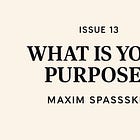Stop Treating Your Mind Like a Closet
A simple systems lens to sort what stays, park what doesn’t, and recover faster after drift.
I’ve been writing for more than a year now. That still feels unreal to me.
I never thought I could pull that off. Every time I tried before, I’d manage a post or two, then stall. The motivation faded, the excuses piled up, and soon the blog was abandoned.
This time was different. At the start, I had that same internal voice whispering, “This won’t last. A few weeks, maybe, then you’ll quit again.” But here I am, a year later. Proud, honestly. I don’t brag often, but some milestones deserve acknowledgment.
Writing for a year is the first thing in my life I can confidently say I’ve done with discipline. If I quit tomorrow (I won’t), I could still look back and say, “You showed up. You kept going.”
That matters.
The thing is that I don’t just feel disciplined anymore. I actually enjoy it.
So what actually changed?
It wasn’t sudden.
There wasn’t a crazy before-and-after moment. If anything, it crept up on me without my noticing. Only when I looked back, doing the kind of retrospection I always encourage through Adaptable Discipline, did I realize something had shifted.
The irony is that on the surface, nothing changed. My routines weren’t radically different. I didn’t suddenly gain more time, or more energy, or more talent.
The change was in my head: in how I started connecting the dots.
🛑 Before We Continue
Let me take a second to share some reminders.
👉 Check out my book campaign!
I’m writing a book to spread the word on Adaptable Discipline, and I need your help. I created a campaign in Publishizer to bring visibility to publishers. And the best way to do that is through pre-orders.
Check it out and help me by pre-ordering the book or spreading the word.
👉 Don’t forget to join our Disciplined Circle!
For $7.99 a month (or $79.99 a year), you can have access to all the paid companions available, with guidance on how to bring these reflections to action.
As you may know, I’m a software engineer by trade. I spend my days building systems, automating repetitive work, streamlining processes, and making things run more efficiently. But for the longest time, I never thought of my own mind as a place to build a system.
My thoughts were scattered. My knowledge was scattered. The dots were there, but they weren’t connected. It was like pins dropped on a map with no thread between them. You know where the pins are, but you have no idea how to actually travel the road between them.
That’s what started to change.
I began applying the very same thinking I use in my work: setting a direction, deciding how the pins connect, and threading them together toward a destination.
Along the way, I also shifted how I related to myself.
I gave myself more grace.
I practiced self-compassion.
I became more aware. And maybe most importantly, I shortened my “detection latency”: the time between drifting off course and realizing it.
While those changes worked, I think the biggest shift happened when I started noticing the resources already in my hands. Instead of trying to invent new tools, I looked at what I had and asked:
How can these help me move toward where I actually want to go?
Some pins on the map weren’t leading anywhere, so I let them go.
Others pointed straight to the destination I cared about.
That’s when systemic thinking came in. It’s the mindset that allowed me to take the tools I already had, rearrange them, and use them to chart a clearer path through the map.
Systemic thinking isn’t new. It’s been around for a long time. Sure, the rise of digital systems has made it more visible, but people have been applying it in personal and professional contexts for decades.
I’m not the only one exploring how it connects to discipline. That’s why I wanted to bring in
. She writes deeply about systems in her newsletter, Systems Grow People, and her work has shaped how many people think about structure and clarity.Now, as always, I’ll let her take over from here so you can hear it directly from her.
Let’s dive in.
Hey new people, happy to be here! In real life, I’m a Digital Business Manager (or OBM), obsessed with systems that actually support your brain & goals. I partner with founders who are already creating results, but who are drowning in operations, scattered systems, and competing priorities. I’ve spent years witnessing how the right systems don’t just organize work; they organize minds, reduce overwhelm, and create space for what actually matters. My core belief? Systems should help grow people, not constrain them (and that’s how my Substack journey started).
Camilo’s insight about connecting the dots resonates deeply with something I see constantly: the difference between systems that imprison and systems that liberate.
Most people hear “systemic thinking” and picture rigid workflows, endless checklists, or corporate bureaucracy. But what Camilo discovered (and what I’ve been exploring in my work) is that the best systems aren’t about control. They’re about comeback infrastructure.
Traditional productivity systems are built for perfect people living perfect lives.
They assume you’ll never get sick, never lose motivation, never have a chaotic week that throws everything off course. When you inevitably drift (because you’re human), these systems make you feel like a failure.
But systemic thinking in the context of personal development is different. It’s about building infrastructure that expects you to drift and makes returning effortless.
What does this look like practically?
Environmental cues that don’t judge.
Your writing space, your tools, your reminders, they’re not there to shame you for missing yesterday. They’re there to make today’s return as easy as possible.
Systems that remember, so you don’t have to.
When you drift, the last thing you need is to spend mental energy figuring out where you left off. Good systems capture context, track progress, and reduce the cognitive load of re-entry.
Grace built into the structure.
This might be the most important piece. Systems that support comeback speed acknowledge that gaps are data, not failures. They’re designed to help you learn from drift patterns rather than punish yourself for them.
Why This Matters for Discipline
When I work with entrepreneurs who struggle with consistency, the issue is rarely motivation. It’s that their systems fight against their humanity. They’ve built structures that only work when they’re operating at 100%, which means the moment life gets messy (and it always does), everything collapses.
What Camilo describes—that shift from scattered thoughts to connected dots—is exactly what happens when you apply systems thinking to your inner landscape.
Instead of treating your mind like a chaotic closet where you can never find anything, you start treating it like a well-designed workspace. Everything has a place. Related ideas connect to each other. You can find what you need when you need it.
The key is to be aware of how you actually function and stay away from trying to become a productivity robot. Create enough structure that you can be fully human within it. The system holds the framework so your creativity, your intuition, your authentic self can operate freely within that container.
The Meta-System: Learning to Return
Perhaps the most powerful aspect of applying systemic thinking to personal development is this: you start to see the pattern behind all your patterns. You develop the ability to step back and see how your systems are working (or not working) and adjust accordingly (and it’s called “meta-awareness” but I don’t care too much about names).
Camilo mentions shortening his “detection latency” aka the time between drifting and noticing it. This is systemic thinking in action. He’s not just building better writing habits; he’s building better systems for monitoring and course-correcting across all areas of life.
This is where systems truly grow people. When you learn to design supportive infrastructure for one area of your life, you develop the capacity to do it everywhere. The skills transfer. The mindset spreads.
Thanks, Mara, for your reflection.
I appreciate how you brought my angle into your take on systemic thinking in personal development and how kind your words have been.
As Mara writes:
Instead of treating your mind like a chaotic closet where you can never find anything, you start treating it like a well-designed workspace. Everything has a place. Related ideas connect to each other. You can find what you need when you need it.
Systemic thinking showed me something plain and useful. Many of us keep elements we haven’t cleared. We try to force them into a schema. They’re noise.
When we design systems that fit our wiring, we build invisible infrastructure. It runs in the background. It steadies decisions. It shortens the time from slip to return. It increases our comeback speed.
With practice, that rhythm becomes daily discipline. You drift less. You return faster. You notice more.
The work is to focus. Keep the dots that matter. Link them to the direction you chose. Ask:
does this move me in the direction I want to go?
In the next Paid Companion, we’ll go over mental models, tools, and insights to help build a system that fits your wiring and pressure-test it in a simple, repeatable loop.
For now, remember: the idea isn’t to become a productivity robot. It’s to be a human who aligns with their principles and values. Let efficiency be the result, not the aim.
Then it becomes a matter of taking small steps, designing systems to support them, refining, and repeating.
Have a wonderful week!
✨ Ideas Worth Exploring
If this piece resonated, here are a few more that go hand-in-hand.
Enjoying this? Support the mission.
I write Self-Disciplined to help more people build real, lasting discipline — without burnout. If my work has helped you, consider supporting it with a coffee or becoming a member.










Enjoyed reading 👌🏽
The thing is that I don’t feel disciplined anymore. I actually enjoy it
Obsolute 👍